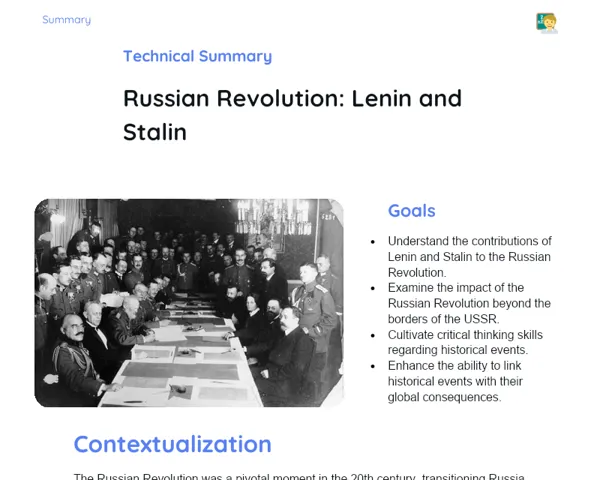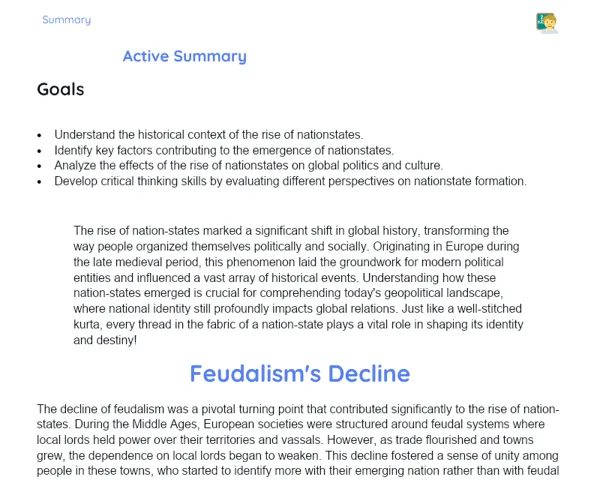Summary Tradisional | Asia: Far East
Contextualization
The Far East, comprising nations like China, Japan, Korea, and Mongolia, is celebrated for its deep-rooted history and vibrant culture. During ancient times and the medieval period, these civilizations achieved remarkable growth, making significant technological and cultural strides that not only shaped their own societies but also had a profound impact on the world at large. For instance, China is lauded for pivotal inventions such as gunpowder, the compass, paper, and printing, whereas Japan is known for its distinctive samurai culture and a unique feudal hierarchal system.
Exploring these civilizations provides us with insight into how their contributions have influenced global development and how their cultures and social systems evolved over time. Korea, home to the Three Kingdoms of Goguryeo, Baekje, and Silla, and Mongolia, famously led by Genghis Khan, highlight the diverse social structures and technological innovations that have shaped world history. The enduring legacy of the people of the Far East is still relevant in today's context.
To Remember!
Groups of Peoples from the Far East
The Far East is home to several vital civilizations, each with unique characteristics and contributions. China, particularly during the Han dynasty, experienced a golden era with notable advancements in science, technology, and culture. The Tang Dynasty, recognized for its robust bureaucratic system and the imperial examination process, fostered meritocracy and cultural blossoming through the promotion of Confucian values.
Japan's Heian period is renowned for its cultural renaissance, during which classical literature and art flourished. This era is significant for literary masterpieces such as 'The Tale of Genji' and for establishing aesthetic practices and rituals that continue to resonate in modern Japanese culture.
Korea, divided into the Three Kingdoms of Goguryeo, Baekje, and Silla, also played a crucial role in the region's cultural and social evolution. Goguryeo is noted for its impressive architecture and mural art, Baekje for enriching Buddhism and artistic expressions, and Silla for unifying the Korean Peninsula and nurturing a vibrant Buddhist culture. Mongolia, under Genghis Khan's command, established the largest contiguous empire ever, uniting tribes into a formidable military force.
-
China: Han and Tang Dynasties, advancements in science, technology, and culture.
-
Japan: Heian period, emergence of classical literature and art.
-
Korea: Three Kingdoms of Goguryeo, Baekje, and Silla, vital cultural and social contributions.
-
Mongolia: Mongol Empire under Genghis Khan, the largest empire in history.
Major Inventions and Technological Advancements
China's technological feats have significantly impacted the world. Initially used in fireworks, gunpowder was adapted for warfare, altering military confrontations. The compass emerged as a crucial tool for navigation, enabling safer and more accurate maritime journeys and promoting extensive explorations. The innovations of paper and movable type printing transformed knowledge-sharing, facilitating the mass production of books and documents.
In Japan, the refinement of the samurai sword, or katana, serves as a prime example of technological and cultural progression. Crafting the katana involved intricate metallurgy, resulting in a highly effective and symbolically significant weapon. Moreover, the tea ceremony emerged as a refined cultural practice, underscoring the significance of rituals, aesthetics, and discipline in Japanese society.
Korea also made notable strides, including the creation of the Hangul writing system during the Joseon Dynasty. Designed for simplicity, this script democratized literacy. Additionally, Goryeo ceramics are renowned for their beauty and sophisticated techniques, showcasing Korean artistic contributions.
-
China: Gunpowder, compass, paper, and movable type printing.
-
Japan: Development of the katana and the tea ceremony.
-
Korea: Hangul writing system and Goryeo ceramics.
Social Organization and Cultural Development
China's social structure during the Tang dynasty was well-organized, characterized by a meritocratic bureaucracy based on the imperial examination. This approach permitted individuals from diverse backgrounds to ascend the ranks of government, fostering administrative effectiveness and social cohesion. Confucianism played a pivotal role in shaping ethics and societal values, leaving an indelible mark on Chinese culture.
Japan's feudal society was distinctly hierarchical, positioning the Emperor at the apex, followed by shoguns, daimyo, and samurais. The samurai class adhered to the Bushido code, a set of ethical principles emphasizing loyalty, courage, and discipline. This system of feudal organization not only structured society but has also significantly contributed to Japanese cultural identity over centuries.
In Korea, the Joseon Dynasty instituted a rigidly Confucian social hierarchy, clearly delineating classes and placing a strong emphasis on education and familial bonds. This framework helped solidify societal structures and promote stability, with Confucian influence permeating Korean art, literature, and ceremonial practices.
-
China: Meritocratic bureaucracy and imperial examination, Confucian influence.
-
Japan: Feudal structure, samurais, and the Bushido code.
-
Korea: Confucian social hierarchy during the Joseon Dynasty.
Global Impact and Contemporary Relevance
The innovations from the Far East have had a lasting influence on global progress. The Chinese compass, for instance, proved invaluable for European exploration, facilitating the discovery and colonization of new lands. Gunpowder has reshaped military strategies worldwide, while paper and printing have revolutionized knowledge dissemination, impacting education and communication on a broad scale.
The social and cultural frameworks of these societies also left their mark on other cultures. The Bushido code from the Japanese samurais has inspired concepts of discipline and loyalty in various societies. The Chinese meritocratic system, rooted in the imperial examination, has influenced modern examination and evaluation systems.
Studying these civilizations not only enriches our understanding of history but also offers insightful lessons for contemporary society. Cultural practices, from Japan's tea ceremony to Korea's Confucian rituals, are still preserved and celebrated, illustrating the enduring relevance of these traditions in the cultural identities of the Far East.
-
Impact of Chinese inventions on navigation, military practices, and communication.
-
Influence of the Bushido code and Chinese meritocracy on various cultures.
-
Significance of cultural traditions in shaping the modern identity of the Far East.
Key Terms
-
Far East: Region including China, Japan, Korea, and Mongolia.
-
Han Dynasty: Golden age in China characterized by advancements in science and culture.
-
Heian Period: Flourishing of classical Japanese culture.
-
Three Kingdoms of Korea: Goguryeo, Baekje, and Silla.
-
Genghis Khan: Leader who established the largest contiguous empire in history.
-
Gunpowder: Chinese invention first used for fireworks and later adapted for warfare.
-
Compass: Vital Chinese invention for navigation.
-
Paper and Printing: Revolutionary Chinese inventions for knowledge sharing.
-
Katana: Traditional Japanese samurai sword.
-
Tea Ceremony: A refined cultural practice in Japan.
-
Hangul: The Korean writing system.
-
Goryeo Ceramics: Korean artistry celebrated for its aesthetic and technical excellence.
-
Meritocratic Bureaucracy: Chinese administrative system based on examination results.
-
Bushido: The honor code of Japanese samurais.
-
Confucianism: Philosophical doctrine that influenced the social and cultural frameworks of China and Korea.
Important Conclusions
In studying the Far East during ancient and medieval times, we delved into the prominent civilizations of the region, including China, Japan, Korea, and Mongolia. Each of these cultures developed distinctively, contributing significantly to technology and culture that have resonated throughout global history. China, for example, is recognized for inventions like gunpowder, the compass, paper, and printing, while Japan is noted for its rich samurai heritage and intricate feudal structure.
We also analyzed the varying social and cultural frameworks within these societies. China’s establishment of a merit-based bureaucracy via the imperial examination, Japan's structured feudal hierarchy under the Bushido code, and Korea's adherence to a Confucian structure illustrate the complexity of their social landscapes. Moreover, Mongolia, led by Genghis Khan, unified tribals into the largest contiguous empire known to history.
Ultimately, we realize how these ancient civilizations have bequeathed a rich legacy that remains pertinent today. Their innovations have transformed practices worldwide, from navigation to education. The cultural traditions of these regions continue to sculpt identities today, underscoring the importance of studying and preserving such a vibrant historical heritage.
Study Tips
-
Review the visual materials and supporting texts provided during the lessons. They contain detailed information that can help reinforce and expand your understanding of the topics discussed.
-
Watch documentaries and videos about the civilizations of the Far East. Audiovisual resources can provide a more engaging and comprehensive understanding of their history and culture.
-
Practice answering the questions discussed in class. This will solidify your knowledge and prepare you for any potential assessments on the subject.



